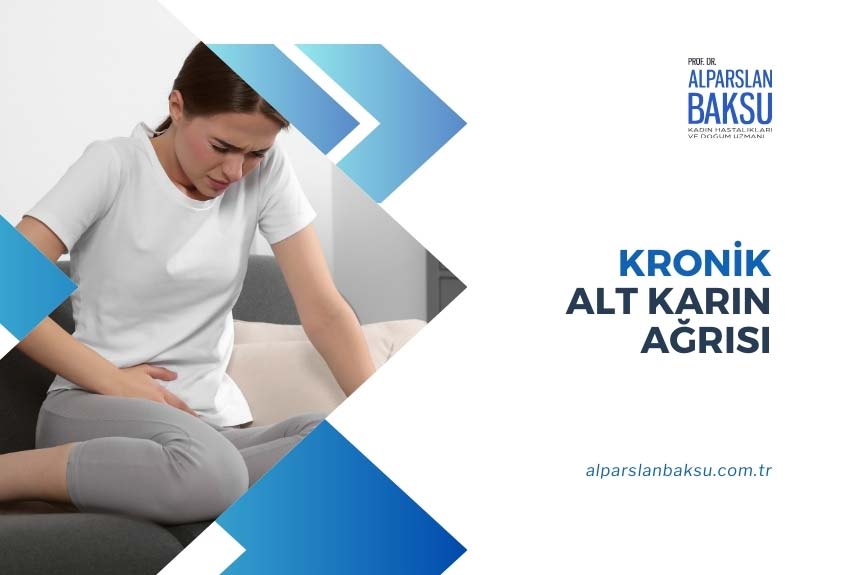CHRONIC LOWER ABDOMINAL (PELVIC) PAIN
Chronic lower abdominal pain is a disease that negatively affects a woman's social life and is difficult to cope with. The incidence in women is estimated to be 3-4%.
Which pains are called chronic lower abdominal (pelvic) pain?
Pain that is located below the umbilicus or in the lower abdomen, persists for six months or longer, causes restrictions in a woman's life, and may be related or unrelated to menstrual bleeding is called chronic lower abdominal (pelvic) pain. It causes restriction of movement in women, loss of labor force (due to not being able to go to work), negativities in sexual life, and impairs the quality of life due to constant drug use.
What are the main reasons?
We can summarize the causes of this condition, which can be seen due to many reasons other than gynecological diseases, as follows, in order of frequency:
1. Causes related to gynecological diseases:
a. Chronic pelvic infection and adhesions between female genital organs: Inflammatory diseases that are not treated on time and properly can become chronic and cause adhesions in this area.
b. EndometriosisEndometriosis is detected in approximately 30% of patients who undergo laparoscopy due to chronic lower abdominal pain.

c. The presence of ovarian remnants (some ovarian tissue) in patients whose uterus and ovaries have been surgically removed, or the remaining ovaries in patients whose uterus has been removed, can sometimes lead to chronic lower abdominal pain.
D. Varicose veins in the lower abdomen (pelvic congestion syndrome): The veins in this area have varicose veins, just like in the legs. This causes chronic pain.
e.in the womb myomas and the disease called adenomyosis are also among the causes.

f. Ovarian tumors: Benign or malignant ovarian tumors are also causes of chronic lower abdominal pain.
2. Causes related to the gastrointestinal system:
a. Irritable bowel syndrome: causes pain with excessive movement in the intestines.
b. Chronic appendicitis: Causes chronic right lower abdominal pain.
c. Chronic ulcerative (inflammatory) bowel disease: It is among the causes of diseases that cause ulcers in the intestines, such as ulcerative colitis and Crohn's.
3. Causes related to the urinary tract:
a. Chronic urinary tract infections: It is more common in older women (over 60 years of age).
b. Chronic bladder inflammation (interstitial cystitis): Causes frequent urination and groin pain.
c. Urethral syndrome: It causes complaints such as frequent and difficult urination and groin pain.
4. Causes related to the musculoskeletal system:
a. Chronic pain of the coccyx bone (coccydynia): Falls or damaging effects on this area can cause chronic pain.
b. Pain may arise from the muscles lining the lower abdomen (levator ani).
5. Pain caused by psychological reasons:
There is a close relationship between depressive nature and pain. Chronic pain is also common in women with unresolved psychological problems. Treating depression in these people will also treat pain.
How is chronic lower abdominal pain treated?
These patients should first be questioned and examined very carefully. Sometimes there may be more than one underlying cause. In patients where a diagnosis cannot be made through history, examination and tests, the abdominal cavity is examined directly visually with a surgical method called laparoscopy and a diagnosis is made. Surgery will usually provide a solution for causes related to gynecological diseases. adhesions Treatment is performed by opening the tumor, removing fibroids, removing tumors in the ovaries, and sometimes removing the uterus and ovaries together. In the treatment of varicose veins in the lower abdomen, the uterus and ovaries are removed.

If a definitive cause related to gynecological diseases is not found as a result of the examinations, the opinions of experts on the urinary tract (urologist), stomach-intestine (gastroenterologist), musculoskeletal system (orthopedics) and psychological disorders (psychiatry) are consulted. An attempt is made to obtain results with treatment appropriate to the identified problem. But a definitive cause cannot always be determined. In such cases, treatment is not easy. Results are tried to be achieved with a patient approach and psychotherapy.



Leave a Reply